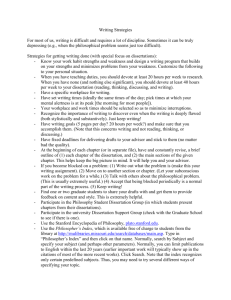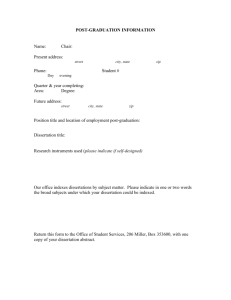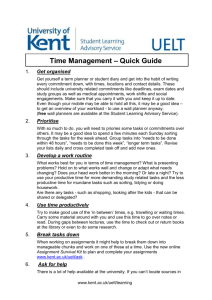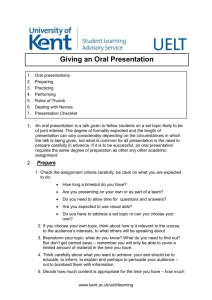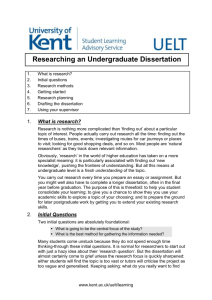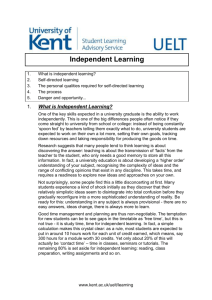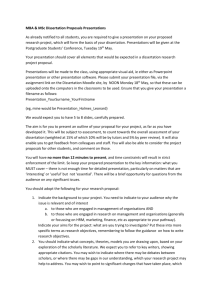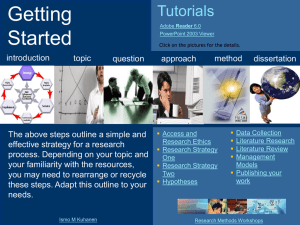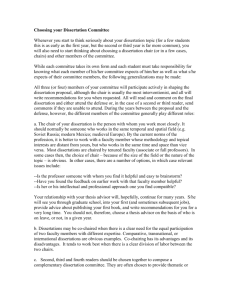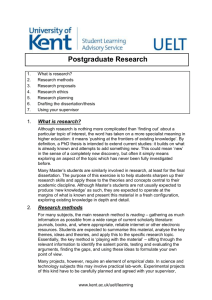Project managing your research
advertisement
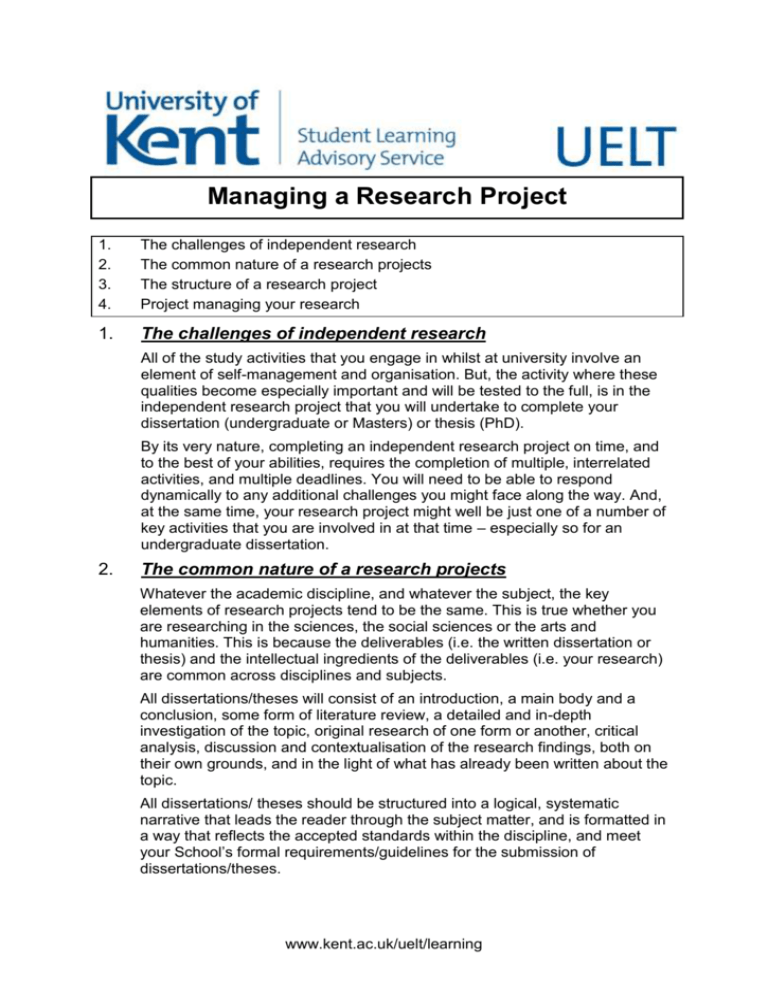
Managing a Research Project 1. 2. 3. 4. The challenges of independent research The common nature of a research projects The structure of a research project Project managing your research 1. The challenges of independent research All of the study activities that you engage in whilst at university involve an element of self-management and organisation. But, the activity where these qualities become especially important and will be tested to the full, is in the independent research project that you will undertake to complete your dissertation (undergraduate or Masters) or thesis (PhD). By its very nature, completing an independent research project on time, and to the best of your abilities, requires the completion of multiple, interrelated activities, and multiple deadlines. You will need to be able to respond dynamically to any additional challenges you might face along the way. And, at the same time, your research project might well be just one of a number of key activities that you are involved in at that time – especially so for an undergraduate dissertation. 2. The common nature of a research projects Whatever the academic discipline, and whatever the subject, the key elements of research projects tend to be the same. This is true whether you are researching in the sciences, the social sciences or the arts and humanities. This is because the deliverables (i.e. the written dissertation or thesis) and the intellectual ingredients of the deliverables (i.e. your research) are common across disciplines and subjects. All dissertations/theses will consist of an introduction, a main body and a conclusion, some form of literature review, a detailed and in-depth investigation of the topic, original research of one form or another, critical analysis, discussion and contextualisation of the research findings, both on their own grounds, and in the light of what has already been written about the topic. All dissertations/ theses should be structured into a logical, systematic narrative that leads the reader through the subject matter, and is formatted in a way that reflects the accepted standards within the discipline, and meet your School’s formal requirements/guidelines for the submission of dissertations/theses. www.kent.ac.uk/uelt/learning 3. The structure of a research project At a basic level, a university research project of any length and at any level can be categorised into ten activities that need to be completed in order to complete the assignment: 1. Choose your research area This is the general area within your academic field where you intend to conduct your research; usually it will relate to an area you have already studied or are studying, since you will be better placed to identify potential research topics than with an entirely new area. It should also be an area that you find particularly interesting, since your interest in the subject is going to be vital in sustaining your engagement. Finally, it should also be a subject area where it is going to be possible to find a suitable supervisor within the University, and you have access to reliable resources. 2. Conduct preliminary research (scope out the topic) This involves surveying current research literature, getting advice from academic staff and reflecting carefully, in order to work out what has already been written about your chosen subject area, and to identify more clearly what it is that you can do that is different to what has been done before. 3. Decide your research topic This involves formulating a clearly defined and delineated research topic. The more clearly your research topic is defined at the start of your project, the better. This will give you confidence and clarity in what you are trying to achieve, and will allow you to monitor your progress more effectively. If you’re not sure of what you’re trying to achieve, then how will you know whether you’re on schedule or not – whether you’re on course or not? At this stage you might also formulate a provisional research question – that is, the question your research will answer: Research topic: Investigate ‘A’ and ‘B’ to see if/how they interrelate. Research Question: ‘To what extent is A caused by B?’ 4. Decide your methodology At the same time you are deciding your topic, you should be investigating and thinking about your research methodology – the way in which you will conduct your research. Is your research going to be experimental, observational, theoretical, textual, qualitative, quantitative, etc.? Will it involve human subjects? Are there ethical considerations – specific protocols, procedures, approaches to follow? Think about why you intend to conduct your research the way you have chosen; what advantages does this give? What insights might it yield? What difficulties might it pose? 5. Submit/present your research proposal for approval Most Schools will have a formal deadline for receiving research proposals/dissertation plans, and a formal approval process. In some cases this is an assessment stage – so make sure you know exactly what you need to submit and when in order to progress with your project. www.kent.ac.uk/uelt/learning 6. Finalise your topic & methodology You may need to revise your research plan in the light of feedback you receive during the approval process. Many students are overambitious in their aims; academic staff have a much clearer idea of what is achievable and what is necessary in terms of a successful research project. Be guided by their advice. Also, you might need to modify you methodology in the light of your initial research (or a pilot study); e.g., the questionnaire you designed needs altering since it isn’t generating the data you were expecting. 7. Conduct you research (fieldwork) This might take place in a laboratory, in a library or archive, at a computer, on the streets or in a field. Whatever the location, this is the practical activity of collecting raw information/data. NB: what you thought you were going to find out, and what you actually find out, can quite often end up being different, so always be prepared to alter your research aims/question accordingly. 8. Analysis/data processing Whatever your research topic, you will need to analyse/process your raw information/data in order to make sense of it. This might involve statistical analysis, generating graphs, charts or tables, organising information into discrete categories, and so on – or it might involve historiographic or critical analysis of texts or events. Whichever, it is important that you not only find something out, but that you understand what it means within your academic field. 9. Writing up This is the process of producing the written document that your research project will be assessed on – your dissertation or thesis. NB: Writing up includes editing, proof-reading, formatting and binding your dissertation; don’t underestimate how long this will take – especially the referencing. You will also need to make sure that any graphs/images are properly numbered and labelled, and referred to and discussed within your main text. 10. Submission All academic research projects are time-constrained. That is, you will have a specific deadline for submitting you work. With longer research projects, you will also have intermediate deadlines (e.g., progress/upgrade boards). What this means is that you have a finite amount of time in which to complete your research project, and, by definition, that you will need to time-manage each stage in order to ensure that you complete the project as a whole on time. 4. Project managing your research Any complex project involving multiple activities and deadlines requires some form of management. Using simple project management techniques will allow you to keep control of your research project – to schedule your work more effectively, to identify how much time you have to spend on each stage of your project, to create intermediate goals/milestones that will tell you if you’re on schedule or not (and be able to respond accordingly), and will give you www.kent.ac.uk/uelt/learning clear oversight of progress of your project as a whole. One simple but highly effective technique is to produce a Gantt chart. This provides you with a clear visual plan of your research project, based on scheduling the different stages of your project against a time base. The below example (Figure 1) is based on the ten basic research project stages, scheduled against two (hypothetical) formal deadlines – submission of the proposal in week 10 and submission of the finished dissertation in week 24: Choose research area Preliminary research Decide research topic Decide methodology Submit/present proposal Finalise methodology Conduct research Analyse data Write up Wk24 Wk23 Wk22 Wk21 Wk20 Wk19 Wk18 Wk17 Wk16 Wk15 Wk14 Wk13 Wk12 Wk11 Wk10 Wk9 Wk8 Wk7 Wk6 Submit assignment Figure 1: Simple research project Gantt chart This example is typical of an undergraduate or taught Masters’ dissertation. Longer research projects (PhD, Masters by research, etc.) will generally have more activities spread over a longer timeframe (See below, Figure 2, for an example of a project plan for a humanities PhD). In project management, the scheduling of individual activities/tasks is always worked backwards from the deadline. Thus, the amount of time that you have to complete each task is a function of the overall project schedule. As shown above, some tasks have to be carried out consecutively (i.e., you can’t start the next task until you’ve completed the previous one), but other tasks can be carried out concurrently (i.e., at the same time), while other tasks can be started before the previous task has been completed, but cannot themselves be completed until after the previous task is completed (e.g., you might be able to start analysing your data whilst you’re still collecting it). What you also need to bear in mind with undergraduate dissertations is that your research project constitutes only one part (25%) of your academic activities, and that you’ll be working on other assignments, reading, exam revision, etc, at the same time. As such, it is important that you make full use of the time period have available, and balance your priorities accordingly. www.kent.ac.uk/uelt/learning Year 1 Activity 1 2 3 4 5 6 7 Year 2 8 9 10 11 12 1 2 3 4 5 6 7 Year 3 8 Literature Search (confirm gap) Draft Research Question/Topic Scope out research (initial thesis plan) Draft Bibliography Reading (2ndary lit) Draft Literature Review (define gap and contexts) Feedback on Literature Review Complete Literature Review Conduct Research Draft Initial Chapters Feedback on initial Chapters Draft Introduction (detailed thesis plan/research question) Feedback on Introduction Draft Middle Chapters Feedback on Middle Chapters Draft final Chapters Feedback on remaining chapters Complete all Chapters Complete Introduction Draft Conclusion Feedback on Conclusion Complete Conclusion Complete Bibliography Write abstract / acknowledgements / index Proofreading Printing & Binding Submission Figure 2: Humanities PhD example Gantt chart www.kent.ac.uk/uelt/learning 9 10 11 12 1 2 3 4 5 6 7 8 9 10 11 12
